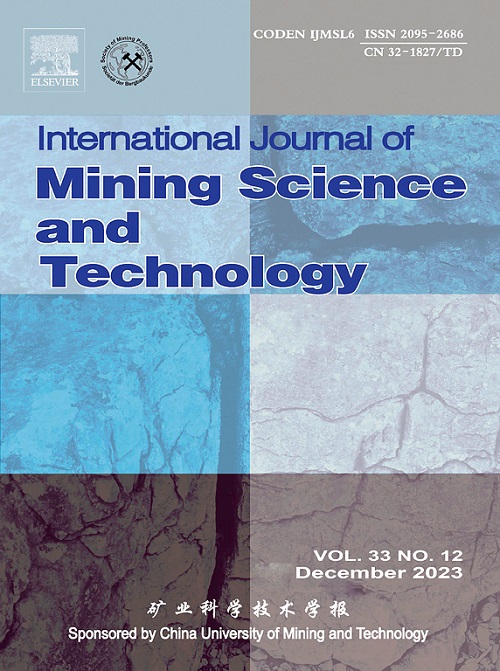A multi-dimensional percussion method for efficient drilling in HDR formations: Rock fragmentation mechanism, drilling energy analysis, and performance optimization
IF 13.7
1区 工程技术
Q1 MINING & MINERAL PROCESSING
International Journal of Mining Science and Technology
Pub Date : 2025-08-01
DOI:10.1016/j.ijmst.2025.07.005
引用次数: 0
Abstract
Percussion drilling is a promising approach for hot dry rock (HDR) fragmentation. However, understanding of HDR fragmentation mechanism under multi-dimensional percussion remains limited and hinders the corresponding drilling performance. Herein, an innovative true triaxial multi-dimensional percussion device was developed for the study of HDR fragmentation mechanism under in-situ temperature and stress conditions. Multi-dimensional percussion, involving both axial and torsional components, was applied to drilling in granite and carbonatite rocks sampled from the typical HDR target areas. Multi-scale visualization techniques and a whale optimization-variational mode decomposition algorithm were employed to investigate the rock failure patterns and drilling energy characteristics. Results indicated that multi-dimensional percussion enhances brittle-ductile mixed failure in granite, characterized by transgranular, intergranular, and combined fracture patterns that promote rock cracking. In contrast, carbonatite drillhole displays enhanced brittle fragmentation and tortuous failure surface dominated by transgranular fracture pattern. Frequency-domain characteristics of penetration force signals for multi-dimensional percussion, especially the significant dominant frequency, amplitude, and high-frequency dissipation, indicate an increase in net energy for drilling into HDR and intensified rock fragmentation. Further, the effect of impact frequency on rock fragmentation performance was emphasized to maximize drilling efficiency. The optimal regulation schemes between axial and torsional impact frequencies are identified as 15 Hz + 15 Hz for granite and 30 Hz + 15 Hz for carbonatite. The reliability of the optimization approach was validated through a field test that employed a novel impactor in the geothermal well Fushen-1.
HDR地层高效钻井的多维冲击方法:岩石破碎机理、钻井能量分析与性能优化
冲击钻井是一种很有前途的热干岩破碎方法。然而,对多维冲击作用下HDR破碎机理的认识仍然有限,影响了相应的钻井性能。为此,开发了一种创新的真三轴多维冲击装置,用于研究原位温度和应力条件下HDR破碎机理。多维冲击包括轴向和扭转分量,应用于从典型HDR靶区取样的花岗岩和碳酸盐岩的钻探。采用多尺度可视化技术和鲸鱼优化-变分模态分解算法研究岩石破坏模式和钻井能量特征。结果表明:多维冲击增强了花岗岩的脆性-韧性混合破坏,表现为穿晶、沿晶和复合破坏模式,促进岩石开裂;碳酸盐岩钻孔脆性破碎增强,破坏面以穿晶断裂模式为主。多维冲击侵彻力信号的频域特征,特别是显著的主导频率、幅值和高频耗散,表明钻入HDR的净能量增加,岩石破碎加剧。进一步强调了冲击频率对破岩性能的影响,以实现钻井效率最大化。确定了轴扭冲击频率的最佳调节方案:花岗岩为15 Hz + 15 Hz,碳酸盐岩为30 Hz + 15 Hz。通过在福深1号地热井采用新型冲击器的现场试验,验证了优化方法的可靠性。
本文章由计算机程序翻译,如有差异,请以英文原文为准。
求助全文
约1分钟内获得全文
求助全文
来源期刊

International Journal of Mining Science and Technology
Earth and Planetary Sciences-Geotechnical Engineering and Engineering Geology
CiteScore
19.10
自引率
11.90%
发文量
2541
审稿时长
44 days
期刊介绍:
The International Journal of Mining Science and Technology, founded in 1990 as the Journal of China University of Mining and Technology, is a monthly English-language journal. It publishes original research papers and high-quality reviews that explore the latest advancements in theories, methodologies, and applications within the realm of mining sciences and technologies. The journal serves as an international exchange forum for readers and authors worldwide involved in mining sciences and technologies. All papers undergo a peer-review process and meticulous editing by specialists and authorities, with the entire submission-to-publication process conducted electronically.
 求助内容:
求助内容: 应助结果提醒方式:
应助结果提醒方式:


